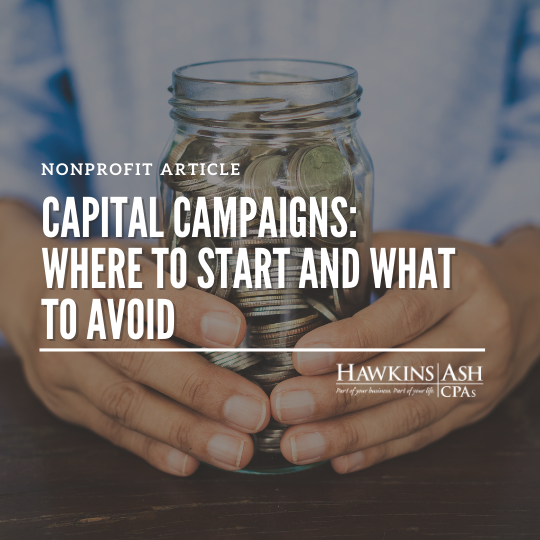Most not-for-profit entities have at least considered running a capital campaign at one point, but many do not know where to start. By definition a capital campaign is an intense fundraising event that could span several years for a specific purpose.
In order to have a successful capital campaign, management, the accounting department and the board of directors of the entity should sit down and discuss why they need a capital campaign, how much is needed for the project and decide if they are ready to start.
The first step in starting a campaign is creating a strategic plan on how the campaign will be conducted. Many questions need to be answered before the campaign can be started. The planning phase is where to find the answers. Here are some steps to get started on a capital campaign:
1. Develop a team to spearhead the campaign.
An ideal committee should consist of members of the Executive, Finance and Development teams as well as the board of directors and additional members as needed. Try and choose team members who have strong connections in the community. This team could also include a fundraising consultant. Consistent and clear communication is key so team members understand what is going on during all aspects of the campaign.
2. Determine the goal of the capital campaign.
Define how much is needed to complete the project and how long should the campaign be held. A comprehensive budget will include anticipated revenues as well as costs for the entire project. By creating a budget, it will be easier to create progress reports that show potential and existing donors the status of the campaign.
3. Conduct a feasibility study to see if the community will support the campaign.
Thirty to forty individuals in the community should be interviewed, including an employee of the entity, a present and past board member of the entity, community leaders and known major donors.
4. Make a list of prospective donors.
Start this list with approximately 15-20 leaders depending on the size of the community. Contact these leaders by writing a letter or an email letting them know that the entity is thinking of holding a capital campaign and would like their advice before moving forward. Create a short list of 6-8 questions to ask concerning holding the capital campaign. Let the prospective donors know the approximate time it will take for this conversation. This is not the time to ask for a donation, but simply a meeting to get feedback.
5. Create a case statement for the campaign to give to donors.
It should state why the project is needed, how the project can be completed, and what the impact of the donor’s contribution will have on the project and the community.
No matter how thorough the planning is, there are still pitfalls that should be avoided to ensure a successful capital campaign.
1. Not completing a feasibility study.
This is one of the largest errors an entity can make. Without the study, the campaign committee will be working in the dark which could lead to misinformation or no information at all. The more information, the greater opportunity to have a successful campaign.
2. Having an unattainable goal.
This, too, is an error that could lead to an unsuccessful campaign. This is one of the areas where a feasibility study will help determine an achievable goal.
3. Not detailing how the funds will be held within the entity.
Ensure the campaign materials that are presented to donors are specific in how the funds will be used. If part of the campaign is creating an endowment, be sure to indicate if those funds will be considered board designated or held in perpetuity.
4. Going into the public phase (when donations are solicited from the general public) too soon.
This could lead to less funds raised than if the public phase had been delayed. During the quiet phase (when donations are solicited from major donors and corporations) of the campaign, at least 50% – 75% of the goal should be reached.
5. Forgetting to say thank you for a donation or pledge throughout the campaign.
A thank you letter should be sent out within 24-48 hours after the gift has been received. Throughout the campaign, thank you letters, emails and/or phone calls should be given to ongoing donors as well as one time donors. By keeping in contact with donors, they will be more likely contribute to future campaigns.
6. Not involving the accounting department from the onset of the campaign.
Recording the campaign is an important part of the process. The accounting and development departments should reconcile their books monthly to catch errors timely and discuss factors to consider in developing an allowance for uncollectible pledges. Procedures for writing off pledges should also be created and documented to ensure the integrity of the campaign. Too often, this aspect is overlooked and leads to large write offs at the end of the campaign rather than as they occur. Improperly recording the campaign pledges, receivable, revenues, and expenses could result in misstated financial statements. Overstating revenues or understating expenses could lead to donors believing the goal has been met and the entity does not need their donation.
Not-for-profits are not all made from the same mold and will have different circumstances that need to be addressed to have a successful campaign. The steps mentioned above are just a few of the more common ways to ensure a successful campaign and prevent errors to avoid an unsuccessful one. Strategic discussions and planning every aspect of a capital campaign will lead to a successful campaign.
Please contact your Hawkins Ash CPAs representative if you have questions related to capital campaigns.





